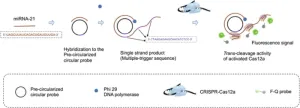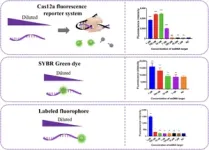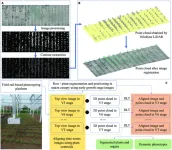(Press-News.org)
In the early 1990s, scientists who were studying the development of a roundworm identified a small RNA molecule that regulated the expression of specific genes. This marked the discovery of microRNAs (miRNAs), which are now known to be present across all forms of life. As it turns out, these molecules play essential roles in many biological processes.
A few years later, researchers realized that diseases could dysregulate the expression of miRNAs, highlighting their potential as biomarkers. In fact, abnormal miRNA expression is a hallmark of all tumor-related diseases. Thus, miRNA detection techniques may be useful for the early detection of cancer.
However, miRNAs are small and degrade easily, which makes their rapid detection and quantification difficult. To detect miRNAs in a sample, it is usually necessary to first ‘amplify’ them. Put simply, this means replicating a target miRNA multiple times via biochemical processes so that said miRNA is easier to detect through inexpensive methods. Unfortunately, most state-of-the-art techniques for miRNA amplification can take over five hours to complete, limiting their use in point-of-care testing.
Against this backdrop, a research team, including Associate Professor Chong Zhang from Tsinghua University, China, recently pioneered a new methodology for fast miRNA amplification and detection. As explained in their latest paper, which was published on March 27, 2023, in BioDesign Research, the team combined two well-studied biochemistry techniques into one in a way that greatly reduced the overall time required.
The first technique they used is called rolling circle amplification (RCA). In RCA, the idea is to design a circular DNA molecule or ‘probe’ to which the target RNA fragment binds. Then, once DNA polymerase enzymes and the necessary DNA building blocks are introduced, the RNA fragment is extended by adding nucleotides complementary to the circular probe. This process results in a long, single strand of genetic material that contains multiple copies of the circular probe.
This is where the second technique, CRISPR-Cas12a, comes into play. The CRISPR-Cas12a is a widely used genetic tool in which a molecular complex is engineered to bind to a specific DNA sequence. In this case, the researchers designed the complex so that it would bind to a region in the complementary sequence to the circular probe. That is, the CRISPR-Cas12a complexes bound multiple times along the single-strand of DNA that was produced via RCA. Once these complexes were bound, the Cas12a portion activated, splitting a fluorescent probe from its quencher. In turn, this created an easily detectable fluorescent signal that was brighter the more the initial target RNA was amplified.
Besides the combination of these techniques, the researchers improved the reaction time of the RCA step by using ‘precircularized probes.’ That is, unlike most standard RCA procedures, the probes were given their circular shape prior to the reaction. As Prof. Zhang remarks, this made the detection process much quicker without compromising the system’s performance: “The detection of miRNA could be completed in only 70 min, rather than the usual five hours, with an excellent limit of detection of 8.1 pM and very high specificity.”
Overall, the proposed approach paints a bright future for miRNA detection and their use as biomarkers. Satisfied with the results, Prof. Zhang concludes: “Our design improves the efficiency of CRISPR–Cas and RCA-based sensing strategies and shows great potential in lab-based detection and point-of-care testing.” Since the techniques used in this methodology are not prohibitively expensive nor complex to perform, the widespread adoption of the proposed approach in clinical settings is feasible.
These efforts will pave the way to better diagnostic tools against cancer and other diseases that affect miRNA expression.
###
Reference
Authors
Chenqi Niu1,2, Juewen Liu2, Xinhui Xing1,3, and Chong Zhang1,3
Affiliations
1MOE Key Laboratory for Industrial Biocatalysis, Institute of Biochemical Engineering, Department of Chemical Engineering, Tsinghua University
2Department of Chemistry, Waterloo Institute for Nanotechnology, University of Waterloo
3Center for Synthetic and Systems Biology, Tsinghua University
Corresponding author email: chongzhang@mail.tsinghua.edu.cn
END
Brain tumors located in regions that control speech, vision and motor function present additional challenges to neurosurgeons, as damaging the surrounding tissue can cause severe loss of those abilities.. Because of this, these regions are known as “eloquent brain areas” and require special attention and approaches to limit damage and deficits.
The University of Cincinnati’s Paolo Palmisciano, MD, was part of a research team that examined how well a minimally invasive approach worked to limit vision and hearing loss in patients following brain tumor surgery.
The research was published in the journal Brain Sciences, and the ...
The report, “Wrestling with Social and Behavioral Genomics: Risks, Potential Benefits, and Ethical Responsibility,” produced by The Hastings Center, a bioethics institute, provides direction for research and communications in this area of study with both significant social risks and potential benefits. It is accompanied by an article that describes a fledgling effort to integrate community perspectives on the ethics of this research.
A webinar to launch the consensus report will take place today at 3 PM EST. Register here.
Research on genetic variants and human social and behavioral characteristics, or phenotypes, including anxiety, subjective well-being, ...
The objective of this study is to identify these loci and decipher the polygenic architecture of malic acid content in tomato fruit. The authors carried out a GWAS using six milestone models with two-environment repeats. A series of associated SNP variations were identified from GWAS, and 15 high-confidence annotated genes were obtained based on the lead SNPs and the malic acid accumulation. The optimal allelic combination of the 15 loci was presented for tastier tomato. ...
A severe windstorm that battered the UK more than a century ago produced some of the strongest winds[OS1] that Britain has ever seen, a team of scientists have found after recovering old weather records.
Old weather measurements, first recorded on paper after Storm Ulysses hit the UK in February 1903, have shed new light on what was one of the most severe storms to have hit the British Isles.
By turning hand-written weather data into digital records, the research team has laid the way to better understand other historical storms, ...
The steady decline in cultivable land owing to the rapidly increasing global population has necessitated the use of efficient plant breeding methods that could be used to improve agricultural yields. However, in addition to genetic methods, we need approaches to control and improve complex crop traits. To this end, plant scientists make use of various cutting-edge imaging techniques that quantify crop traits (height, leaf shape, leaf color, etc.). Traditional imaging methods, however, are tedious, destructive, and non-sustainable. ...
Lehigh University materials science and engineering (MSE) professor Masashi Watanabe is the 2023 recipient of the Microanalysis Society Presidential Science Award, which recognizes a senior scientist for “outstanding technical contributions to the field of microanalysis over a sustained period of time.”
Watanabe is a Fellow of the Microanalysis Society and a former MAS president. The career achievement honor highlights his work in advancing quantitative analysis in scanning transmission ...
WASHINGTON, April 24, 2023 – Superconductors can conduct electricity without any resistance or power loss, and they can effortlessly cause magnets to levitate above them. These properties would make superconductors useful for high-speed trains or long-distance power transmission, except for one glaring problem: superconductors only work at low temperatures, more than a hundred degrees below zero.
This one requirement makes building a hyperefficient electrical grid or high-speed rail network very expensive. Unless, that is, a superconductor network could accomplish ...
HIGHLIGHTS
SARS-CoV-2 may spread through contaminated shipping containers
How long Omicron variants persist on shipping materials may be influenced by temperature, humidity and material
Researchers measured the viability of BA.1 and BA.5 Omicron variants on 4 shipping materials
The virus was most stable, and most likely to spread, at the lowest temperature.
Washington, DC – The virus that causes COVID-19 spreads through droplets and small particles, but contaminated surfaces of shipping materials ...
In a first-of-its-kind effort, social media researchers from Drexel University, Vanderbilt University, Georgia Institute of Technology and Boston University are turning to young social media users to help build a machine learning program that can spot unwanted sexual advances on Instagram. Trained on data from more than 5 million direct messages — annotated and contributed by 150 adolescents who had experienced conversations that made them feel sexually uncomfortable or unsafe — the technology can quickly and accurately flag risky DMs.
The project, which was recently published by the Association for Computing Machinery in its Proceedings of the ACM on Human-Computer Interaction, ...
SPOKANE, Wash.—Safety concerns related to the widely used painkiller diclofenac may be tied to a little-studied drug-metabolizing enzyme whose expression can vary as much as 3,000 times from one individual to the next, according to new research.
Published in the journal Clinical Pharmacology & Therapeutics, findings from the study could be used to develop ways to identify individuals at risk of serious side effects from diclofenac and to determine safer dosing standards for specific populations, including women, young children and people of certain ethnicities.
Used to combat pain and inflammation ...






